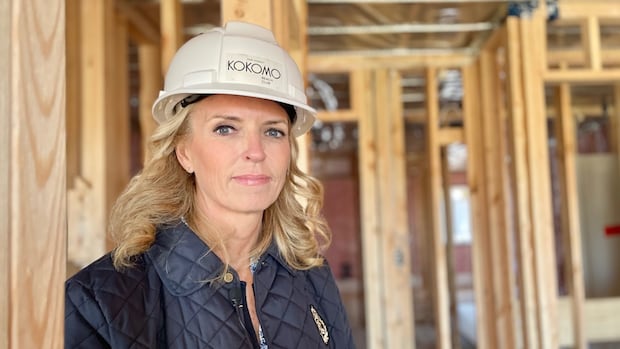
Why Canada is on the cusp of a housing construction crisis | CBC News
Housing is about to get a lot more expensive in the next decade if the federal government does not revamp its immigration program bringing in skilled workers, according to the construction industry.
“We’re really struggling with getting the right type of workers,” said Sue Wastell, president of London, Ont.-based real estate developer Wastell Homes.
Many construction organizations across the country say they don’t have enough labourers doing jobs that don’t require specialized training and the federal immigration system isn’t bringing them in. Considering the number of people expected to retire in the next few years, along with an ambitious housing target to address affordability, homes will get a lot more expensive and out of reach for Canadians.
This is set against the backdrop of the current political climate, when Canadians are feeling increasingly anxious about immigration and the rights given to newcomers, putting the federal government’s recent reduction in immigration targets and increasing housing at odds with each other.
The specific types of jobs that construction companies are lacking are typically referred to as “unskilled labour” — for example, framers, tile setters, window and door installers — where skills are learned on the job and don’t require a certificate, degree or apprenticeship.
The problem is twofold, according to Wastell. Domestically, there aren’t enough people getting into these kinds of jobs, and despite efforts in recent years to increase interest in the sector, it’s not enough to bridge the gap. Furthermore, the federal government’s points-based immigration system, called the comprehensive ranking system, typically only brings in the most highly educated and skilled workers, like engineers.
“It’s really causing a lot of delays and adding extra costs to our overall prices that we have to end up charging the end user.”
According to Statistics Canada, immigrants play a key role in the industry, accounting for 23 per cent of all general contractors and residential builders.
Industry retirements
According to industry organization BuildForce Canada, 22 per cent of the workforce is set to retire in residential construction in the next eight years. That’s approximately 259,100 workers. However, retirements are expected to outpace new entrants into the industry, with 228,100 projected to enter the industry in the same time period. According to Wastell, the pandemic sped up the timeline, with an increase in the number of retirements during those years.
Those statistics are worrying to many companies, especially paired with advocates’ and government goals to make housing more affordable. To address the shortage of housing supply, the Canada Mortgage and Housing Corporation says 5.8 million homes need to be built by 2030 to restore affordability to levels seen in 2004.
Also worrisome — the looming issue isn’t just limited to residential construction, but other projects, too.
“We’re worried,” said Patrick McManus, executive director of the Ontario Sewer and Watermain Construction Association. The organization is comprised of 800 member companies across the province that builds, maintains and operates sewer and watermain infrastructure at the municipal level.
“If these issues aren’t addressed, we are going to deal with problems like rising costs on construction projects, delays in construction projects.”
McManus pointed to the last Canadian Infrastructure Report Card that said 30 per cent of water infrastructure are in fair, poor or very poor condition. Nearly 40 per cent of roads and bridges were in the same condition.
“This is the most critical asset that we own as the general public,” he said.
“We’re going to have some very serious problems unless we’re investing sustainably and growing sustainably.”
He warns of more infrastructure failures as time goes on without the critical workers needed to repair and replace them.
In a statement, Immigration, Refugees and Citizenship Canada (IRCC) told CBC News it plans on convening an advisory council to “assess the needs in the industry and advise on new pathways to bring in the skilled workers we need, a regularization pathway for out-of-status construction workers, and support for foreign apprentices.”
It said it will continue assessing the effectiveness of programs like the points-based ranking system.
On March 7, then-immigration minister Marc Miller announced IRCC would build on the success of pilot programs like one from 2020 in the Greater Toronto Area, which allowed undocumented construction workers to apply for permanent residence. It had admitted roughly 1,365 permanent residents and dependents through the program, as of November 2024. However, with a federal election on the horizon, the initiative’s future is uncertain.
Nova Scotia example
Some provinces have achieved a certain amount of success in bringing in specific workers.
In October 2023, Nova Scotia also launched a pilot program to target the types of jobs it needed.
The Critical Construction Worker Pilot, according to the federal government, allowed candidates with job offers in the construction sector to use “occupational training to meet education requirement[s] and allows alternative proof of language for those with high-skilled job offers.”

The pilot was successful, according to Jeremy Smith of the Department of Labour Skills in Nova Scotia, who said many workers they wanted to bring in left secondary school to pursue a job in the trades.
“That was a barrier to them using our programs,” he said. “[The pilot program] provided that flexibility when it comes to the … high school equivalency.”
Smith said 512 applicants were approved through the pilot in 2024.
However, critics say the federal government should be responsible for rolling out changes, considering the problem is affecting the entire country.
Kevin Lee, CEO of the Canadian Home Builders’ Association, says all provinces are affected by the worker shortage, yet the government is only “tinkering at the edges” of trying to better the express entry pathways.
“At a time when we have a national housing crisis, we shouldn’t be saying, ‘Let’s let the provincial programs figure it out,'” he said.
McManus, with the Ontario Sewer and Watermain Construction Association, says if the problem isn’t addressed now, construction sites could be sitting at a standstill, waiting for workers to arrive for months, within the next five to 10 years.
“We need to modernize and evolve that system,” he said.
Another solution, according to Rupa Banerjee, associate professor of HR management at Toronto Metropolitan University, is to diversify the types of people the country brings in.
“I’m not really strongly in favour of having points for specific occupations because we’re always two steps behind labour market trends and labour market needs.
“We need to make sure that we have a real wide variety of skills and a real wide variety of people.”










